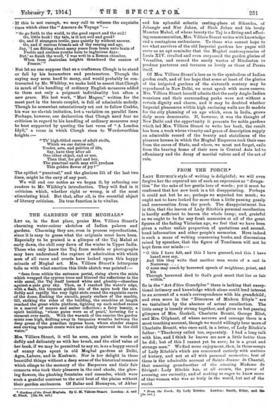THE GARDENS OF THE MIIGHALS.*
Lax us, in the first place, praise Mrs. Villiers Stuart's charming water-colour sketches of Indian palaces and gardens. Charming they are, even in process reproductions, -since it is easy to guess what the originals must have been. Especially to be praised is a glimpse of the Tel Mahal at early dawn, the chill rosy dawn of the winter in Upper India. Those who only know the Taj from models or photographs may here understand the rapture of admiration with which men of all races and creeds have looked upon this happy miracle of Moghal art. Mrs. Villiers Stuart's letterpress tells us with what emotion this little sketch was painted;- " Seen from within the entrance portal, rising above the mists 'which wrapped the cypress trees and blurred the reflections in the wide canal, the Taj itself loomed white and ghostly--cheerless against a pale grey sky. Then, as I reached the water's edge, with a flash, the topmost golden iris of the spire took the sun. Softly and rapidly the rosy light stole round the exquisite curve .of the dome, flashing the smooth, pearly surface of the marble, till, striking the sides of the building, the sunshine at length reached the great white platform, lighting up each arched recess in a marvel of mauve and amber reflection ; a fairy beauty, a spirit building, 'whose gates were as of pearl,' hovering for a moment over earth. With the warmth of the sunrise the garden
• mists rose high, drifting away in turquoise wreaths between the deep green of the guardian cypress trees, whose slender shapes And carving topmost crests were now clearly mirrored in the still water."
Mrs. Villiers Stuart, it will be seen, can paint in words as deftly and delicately as with her brush, and the chief value of -her book, if we may be permitted to say so, is as a happy record -of sunny days spent in old Moghal gardens at Delhi, 'Agra, Lahore, and in Kashmir. Nor is her delight in these beautiful things without a deep sense of the historical romance which clings to the memory of the Emperors and their fair consorts who took 'their pleasure in the cool shade, the glow- ing flowers, the plashing fountains and cascades, which were snob a grateful contrast to the arid heat of the plains without their garden enclosures. Of Babar and Hemayun, 'of Akbar
• Gardena of ale Bract Muslista By 0. X. Wham Matra Ianden, and C. Black. ftes.se. net.]
and his splendid • eclectic resting-place at Sikandra, of Jahangir and Nnr Johan, of Shah Jahan and his lovely Mumtaz Mahal, of whose beauty the Taj is a fitting and affect- ing commemoration, Mrs. Villiers Stuart writes with knowledge and a contagious enthusiasm. To those who cannot hope to see what survives of the old Imperial gardens her pages will serve as an apt reminder that the Moghal contemporaries of Louis XIV. rivalled and even surpassed the garden glories of Versailles, and caused the sandy wastes of Hindustan to produce parterres and terraces as lovely as those of Persia itself.
Of Mrs. Villiers Stuart's lore as to the symbolism of Indian garden craft, and of her hope that some at least of the glories of the irrigated gardens of the sixteenth century may be reproduced in New Delhi, we must speak with more reserve. Mrs. Villiers Stuart herself admits that the early Anglo-Indian mansions and their surrounding parks were not without a certain dignity and charm, and it may be doubted whether• Imperial pleasances within high enclosing walls are fit models for the city planning of an age which, even in India, grows daily more democratic. If, however, it was the thought of New Delhi and the opportunity it presents for noble gardens which led Mrs. Villiers Stuart to write her book, the result has been a work whose vivacity and grace of description supply an admirable record of the beauty and stateliness of the pleasure houses in which the Moghal Emperors took their ease from the cares of State, and where, we must not forget, exile from the bracing home of their race in Central Asia led to effeminacy and the decay of martial valour and of the art of rule.










































 Previous page
Previous page